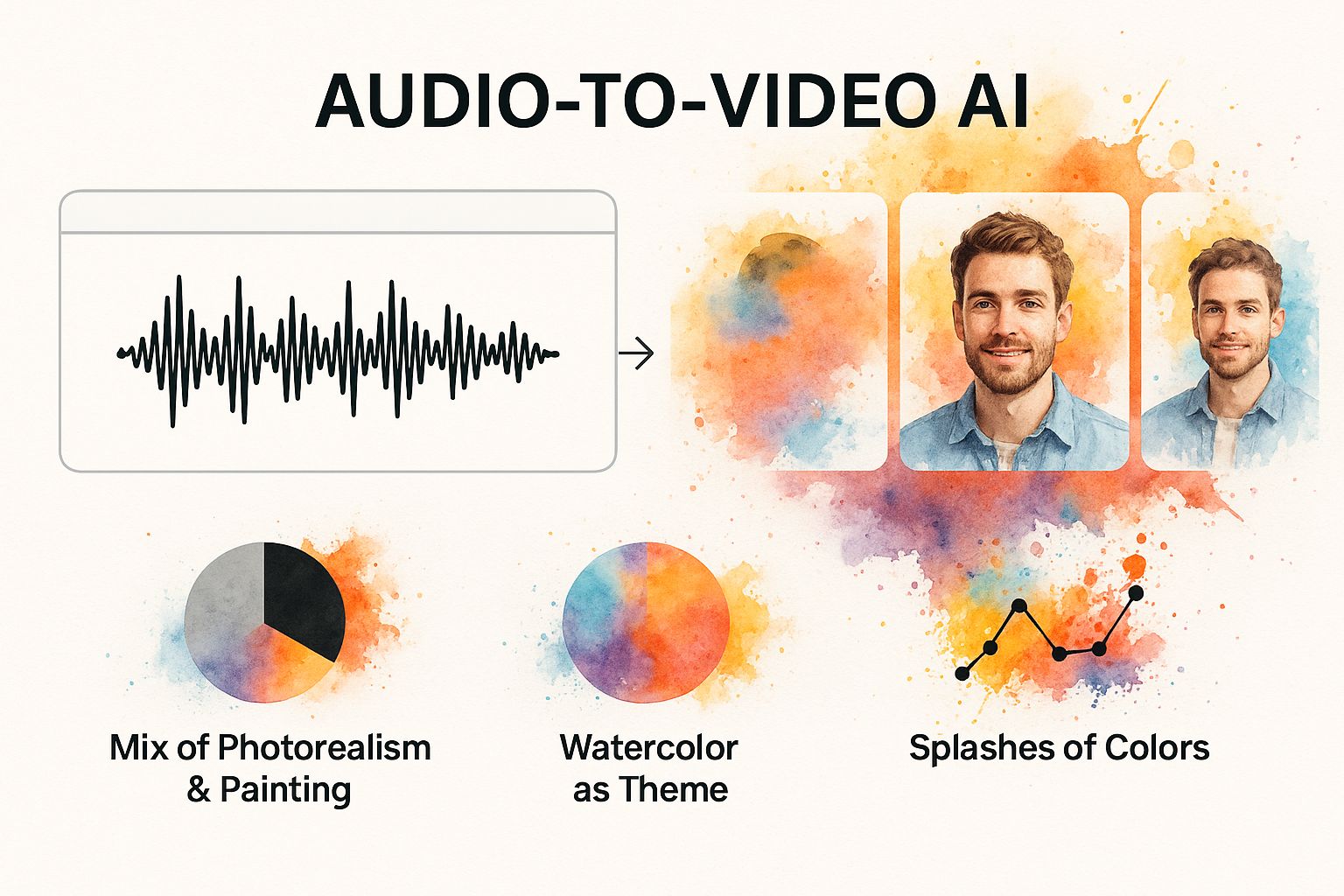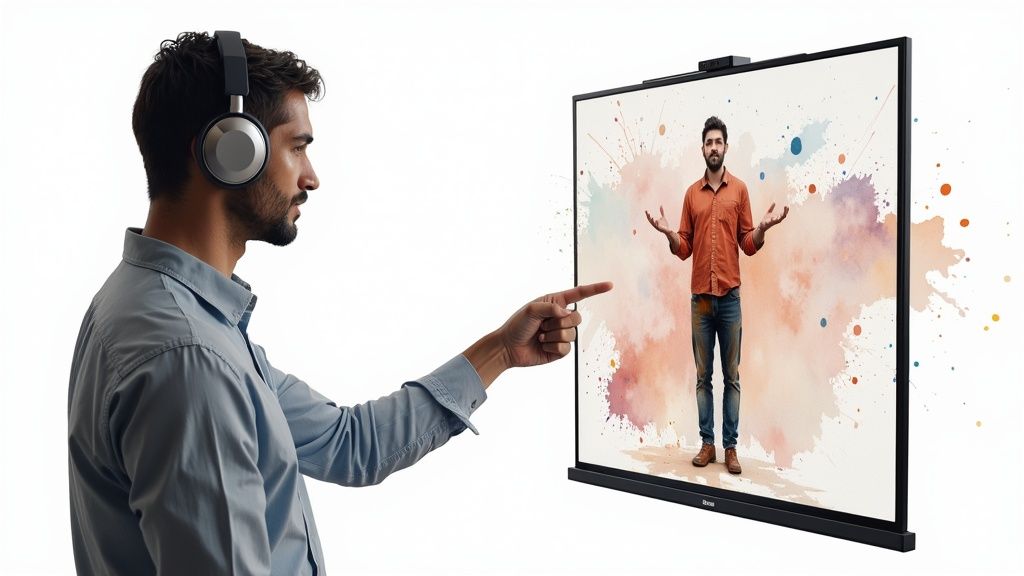Picture a film director who can hear a podcast episode, a voiceover track, or even just a simple audio recording and, almost instantly, spin it into a full-fledged, engaging video. That’s the magic of audio to video AI.
At its core, this technology takes audio files and automatically transforms them into dynamic video content. The result? Video creation becomes dramatically faster, more affordable, and accessible to just about anyone.
The Future of Content Is Listening
In this guide, we’re going to pull back the curtain on how this incredible technology actually works. We'll explore how it's already being used out in the wild—from solo creators turning their podcasts into animated clips for social media, to businesses converting presentations into compelling visual stories.
This isn't some far-off, futuristic idea. It’s a practical tool that’s here today, completely changing how we approach creating and sharing content. It's a game-changer for anyone who needs to produce more video without getting bogged down by the usual high costs and long timelines.

How AI Turns Sound into Visuals
So, how does the magic actually happen? How does an AI take a simple audio file and spit out a fully-formed video? It's less magic and more like having a brilliant interpreter on your team.
First, the AI listens to the audio, much like a smart assistant understands your commands. It doesn't just hear words; it analyzes speech patterns, picks out crucial keywords, and even gauges the emotional tone of the voice. It's this deep analysis that allows it to intelligently match the right visuals from a library or even generate new ones on the fly. This whole process is a fantastic example of modern AI content creation services that are completely changing how we think about producing media.
This process often includes a fascinating step: AI-powered lip-syncing. A specialized animator AI crafts a character's expressions to perfectly match the nuances of the speaker's voice. This is the secret sauce that makes the final video look so convincing and professional—and it's a critical step to elevate your content with AI video generation.
The Generative Media Market Explosion
The surge in audio-to-video AI isn't happening in a vacuum. It’s a core component of a much larger economic and technological shift—the generative media boom, which is completely reshaping how content gets made.
This isn't just a niche trend. The numbers tell a powerful story about where the market is headed.
Generative Audio/Visual AI Market Growth Projections
The projected growth for the audio and visual generative AI market is nothing short of explosive. It highlights just how quickly businesses and creators are embracing automated media production, signaling a major shift in the industry's economic landscape.
| Metric | Value/Projection |
|---|---|
| 2024 Market Value | $15.86 billion |
| 2030 Projected Market Value | $132.59 billion |
| Projected Growth (2024-2030) | ~735% |
Source: Virtue Market Research
A jump from nearly $16 billion to over $132 billion in just six years underscores the immense value being placed on these technologies. This rapid expansion is a clear indicator that automated media creation is moving from a novelty to a fundamental business tool.
This visual shows exactly what we're talking about—how a simple audio waveform can be analyzed and transformed into a full-fledged video sequence.

It’s a perfect illustration of how far we’ve come. Modern tools are no longer limited to just text prompts, which you can see in our roundup of the 10 best text-to-video generators for 2025. Now, AI can interpret the nuances of sound—the tone, pace, and emotion—to create visuals that are truly in sync with the audio.
Real-World Use Cases Transforming Industries
It’s one thing to talk about technology in theory, but it’s another to see it in action. So where is audio-to-video AI actually making a difference? The answer is: pretty much everywhere.
This technology is creating powerful new ways to grab an audience's attention with dynamic visual content. It’s a game-changer for anyone trying to build effective small business video marketing strategies without a Hollywood budget.
For instance, podcasters are now turning their best audio moments into short, shareable clips for social media, massively extending their reach. Educators are converting dry audio lectures into visually engaging lessons that keep students tuned in. And marketing teams? They’re producing video ads at scale from simple voiceovers, cutting down production time from weeks to minutes.
The global AI video market was valued at $3.86 billion in 2024 and is projected to hit $42.29 billion by 2033, showcasing its massive economic impact. You can explore more about these market projections here.
Finding the Right Audio to Video AI Tool
Picking the right platform is about more than just ticking boxes on a feature list. You have to look deeper at what actually matters for your specific goals. Things like final video quality, the variety of available avatar styles, and how easily you can apply your brand kit are what make or break the experience. After all, solid customization is non-negotiable if you want to maintain brand consistency across all your content.
You’re looking for a tool that genuinely works with you.
What to Look For in a Tool
When you're trying out different platforms, it’s easy to get distracted by shiny new features. But from my experience, a few core elements consistently determine whether a tool will be a long-term partner or a short-term headache.
Here’s a breakdown of what to keep an eye on.
To help you compare your options, here’s a quick-glance table of the features that really count.
Feature Comparison of Audio to Video AI Tools
A comparative overview of key features to consider when selecting an audio-to-video AI platform.
| Feature | What to Look For | Why It Matters |
|---|---|---|
| Video & Audio Quality | High-definition output (1080p+), clear audio without artifacts, and smooth frame rates. | Poor quality immediately cheapens your brand and turns viewers away. Professional-grade output is a must. |
| Avatar & Voice Options | A diverse library of realistic avatars and natural-sounding AI voices in multiple languages and accents. | The more options you have, the better you can match the video's persona to your target audience, making it more relatable. |
| Customization & Branding | The ability to upload your own logos, apply brand colors and fonts, and save a "brand kit" for one-click application. | This ensures every video looks and feels like it came from you, reinforcing brand identity and trust. |
| Ease of Use | An intuitive interface, a logical workflow, and helpful tutorials or guides. | A steep learning curve kills productivity. The tool should feel like an extension of your creative process, not an obstacle. |
| Editing Capabilities | In-app tools for trimming clips, adjusting timing, editing captions, and swapping out media assets. | Being able to make quick edits without exporting to another program saves a massive amount of time and effort. |
| Integration & Workflow | How well it fits with your existing tools and processes. Can you easily import content or export finished videos? | The goal is to make your life easier. A tool that creates extra steps or doesn't play well with others is a productivity drain. |
Ultimately, the best tool is the one that feels the most intuitive and slots right into your existing workflow without causing friction.
The right audio to video AI platform should feel like a natural extension of your workflow. Consider integrations and ease of use—can you easily turn articles into videos with these essential tips or does it require complex steps?
The stakes for choosing correctly are only getting higher. The AI audio and video chip market, which is the hardware that powers all this magic, was valued at a staggering $17.05 billion in 2024. This isn’t just some niche trend; it’s a massive technological shift.
Beyond Social Media: Broader Applications
While turning audio into engaging social media videos is a popular use case, the applications are much broader. Think about creating dynamic ad campaigns from simple voice-overs. With the right script, you can generate a whole suite of video ads in minutes, a task that once required a full production team.
For marketers looking to speed up their creative process, combining these platforms with AI ad writing tools can be a game-changer. You can go from a simple concept to a fully-realized video ad campaign in a fraction of the time.

This synergy between different AI tools is where the real power lies. You’re not just automating one task; you’re building an entire content engine that can scale with your ambitions. It’s about working smarter, not harder, to create compelling visual stories from the simplest audio inputs.
Common Questions About Audio to Video AI
Whenever you dive into a new piece of technology, a few key questions always pop up. It's only natural.
You might be wondering: How smart are these AI tools at understanding different languages or thick accents? Can I get it to use my own voice with an AI avatar to make things feel more authentic? And, just as importantly, what are the current rough edges I should know about?
These are exactly the right questions to be asking.
The best audio to video AI platforms are trained on massive, diverse datasets, which makes them quite good at handling various accents. Many also have voice cloning features and a library of different avatar styles to choose from. That said, the technology can still sometimes miss subtle emotional cues or stumble over very specific technical terms. A quick touch-up after the video is generated is sometimes needed to get it just right.
Ready to turn your audio into compelling videos? See how Aeon simplifies the entire process. Start creating with Aeon today